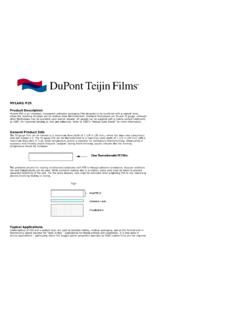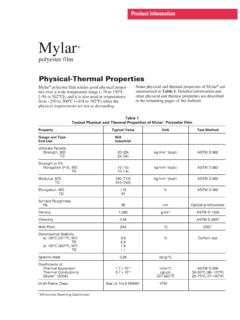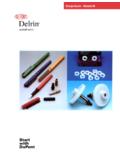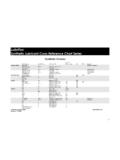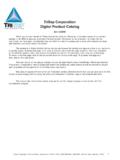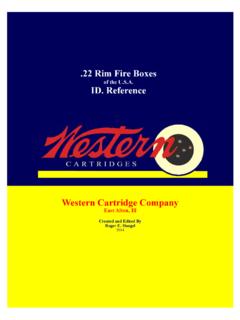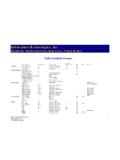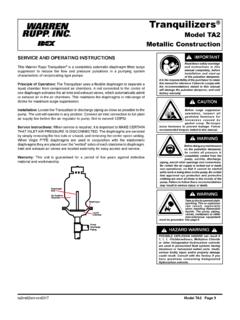Transcription of Mylar - DuPont Teijin Films
1 Polyester filmMylar product InformationPhysical-Thermal PropertiesMylar polyester film retains good physical proper-ties over a wide temperature range ( 70 to 150 C[ 94 to 302 F]), and it is also used at temperaturesfrom 250 to 200 C ( 418 to 392 F) when thephysical requirements are not as physical and thermal properties of Mylar aresummarized in Table 1. Detailed information andother physical and thermal properties are describedin the remaining pages of this 1 Typical Physical and Thermal Properties of Mylar Polyester FilmPropertyTypical ValueUnitTest MethodGauge and Type92 AEnd UseIndustrialUltimate TensileStrength, MD20 (29)kg/mm2 (kpsi)ASTM D 882 TD24 (34)Strength at 5%Elongation (F-5), MD10 (15)kg/mm2 (kpsi)ASTM D 882 TD10 (14)Modulus, MD490 (710)kg/mm2 (kpsi)ASTM D 882 TD510 (740)Elongation, MD116%ASTM D 882 TD91 Surface RoughnessRa38nmOptical D D 2857 Melt Point254 CDSC*Dimensional Stabilityat 105 C (221 F), test 150 C (302 F)
2 , CCoefficients ofThermal 10 5in/in/ CASTM D 696 Thermal 10 4cal cm30 50 C (86 122 F)( Mylar 1000A)cm2 sec C25 75 C (77 167 F)UL94 Flame Class See UL file # E93687 VTM*Differential Scanning Calorimeter2 Tensile PropertiesFigure 1 shows typical stress-strain curves forMylar polyester film at various s ratio is typically before yield after 1. Stress-Strain CurvesTemperature affects the tensile properties ofMylar ; data on a typical sample are shown inFigure 2. When considering the use of Mylar athigh temperatures, reference should be made to thelast five pages of this 2. Tensile Properties vs. TemperatureCompressive PropertiesCompression tests provide information about thecompressive properties of plastics when employedunder relatively low uniform rates of uniaxiallyapplied loading.
3 Data on the compressive propertiesof Mylar polyester film were obtained in accor-dance with ASTM D 695, except that a cylindricalpile of pieces 1 in high, 1 in in diameter, was data are summarized in Table loaded in compression, Mylar did notexhibit a yield point nor did it fail in compressionby a shattering fracture. Therefore, it would beinappropriate to report any value as a compressivestrength. However, the stress at 2% deformationand the stress at 1% offset have been the latter stress occurs at very nearly thepoint where the stress-strain curve begins to deviatemarkedly from the initial relatively linear portion,it is probably a meaningful upper limit for anyapplication where Mylar is loaded in StrengthMylar has a shear strength that is significantlyhigher than published data for other polymericmaterials such as acetals, nylons, and strength was measured by a punch-type oftest according to ASTM D 732 and is reported inthe pounds of force to shear divided by the productof the circumference and the thickness.
4 These testsshowed that 5 and 10 mil Mylar Films have shearstrengths of ( ) and ( ) kg/mm2(kpsi), StabilityThe main factors affecting dimensional stability offilm are strain relief, thermal expansion, hygro-scopic expansion, and creep. Typical values forthese factors are described on following ReliefStrain relief (also called residual shrinkage) occurswhen a film is heated to an elevated resulting shrinkage of the film is merely arelaxation of strains induced during the manufac-ture of the film or during processing of the these strains are relieved at a specific tem-perature, there should be no further shrinkage dueto strain relief as long as that temperature is ,00030,0002,0001,5001,00050025,00020,000 15,00010,0005,0000020406080100120140 Elongation, %Tensile Force, kg/cm2 Tensile Force, psi 70 C ( 94 F) 55 C ( 67 F)0 C (32 F)200 C (392 F)150 C (302 F)100 C (212 F)35 C (95 F)Tensile ModulusMeltingPointTensileStrengthYield StressTransitionPoint1,000,000100,00010, 0001,000100 100( 148) 50( 58)0(32)50(122)100(212)150(302)200(392)
5 250(482)300(572)Tensile Force, psiTemperature, C ( F)3 Some typical curves of shrinkage due to strainrelief are shown in Figures 3 and 4 for two types ofMylar polyester (68)40(104)60(140)80(176)100(212)120(248 )140(284)160(320)180(356)200(392)220(428 )Temperature, C ( F)Shrinkage, %121068420 Figure 3. Shrinkage vs. Temperature Mylar 92 AFigure 4. Shrinkage vs. Temperature Mylar 750 AMDTD20(68)40(104)60(140)80(176)100(212) 120(248)140(284)160(320)180(356)200(392) 220(428)Temperature, C ( F)Shrinkage, %121068420 Thermal ExpansionThe thermal coefficient of linear expansion ofMylar is 10 5 in/in/ C ( 10 6 in/in/ F).As a guide to estimating changes due to thermalexpansion, Figure 5 gives the dimensional changes(in/in) over a wide temperature range. Multiplyingthe indicated change by the sample length gives thethermal dimensional change in the sheet of Mylar .
6 Figure 5. Dimensional Stability vs. TemperatureChanges403020100 10 20 30 40 40( 40) 34( 30) 29( 20) 23( 10) 18(0) 12(10) 7(20) 1(30)4(40)Change in Temperature, C ( F)Size Changes, in/in 10 5 Hygroscopic ExpansionThe hygroscopic coefficient of linear expansionis 10 5 in/in/% RH for Mylar polyester dimensional change due to hygroscopicexpansion over a wide range of humidities isshown in Figure 6. To calculate the total dimen-sional change in a sheet of Mylar due to hygro-scopic expansion, multiply the indicated change bythe linear dimensions of the sheet. Under normalatmospheric conditions, changes in thermal expan-sion tend to compensate for changes in hygroscopicexpansion because rising temperatures usuallyresult in lowering in the relative 2 Compressive Properties of Mylar Polyester FilmMaximumCompressiveStress,1% OffsetMaximum StressStrainModulus,kg/mm2 (kpsi) atStress,During Test,During Test,Film Typekg/mm2 (kpsi)2% Deformationkg/mm2 (kpsi)kg/mm2 (kpsi)% Mylar 1000A289 (413) ( ) ( )21 (30)23 Mylar 1400A278 (397) ( ) ( )21 (30)274 Figure 6.
7 Dimensional Stability vs. RelativeHumidity Changes4530150 15 30 45 40 30 20 10010203040 Change in Relative Humidity, %Size Changes, in/in 10 5 Mylar Type A(320 F). (Drying at these conditions should reducethe water content of the film to less than ; morethan this amount of water must be present in asystem before the film can become embrittled dueto hydrolysis.) Drying at lower temperatures is notas effective in removing water as shown in Figure10. Data for this figure were obtained with samplesof Mylar 1000A conditioned for one month at 22 C(72 F) and 80% RH and then dried under vacuumfor 4 hr at the indicated 7. Tensile Strength of Mylar after Exposureto Steam25,00020,00015,00010,0005,000002505 00750 Time, hr in 100 C (212 F) SteamTensile Strength, psiFigure 9. Tensile Modulus of Mylar after Exposureto Steam0600,000500,000400,000300,000200,00 0100,0000250500750 Time, hr in 100 C (212 F) SteamTensile Modulus, psiCreepMylar is unusually resistant to creep.
8 Two valuesmeasured at room temperature are after260 hr at kg/mm2 ( kpsi) and after1000 hr at kg/mm2 ( kpsi). After 4000 hrat kg/mm2 ( kpsi) in 100 C (212 F) oven,a creep of was StabilityMylar polyester film will hydrolyze and becomebrittle under conditions of high temperature andhumidity, as shown by the effect of steam on thetensile properties of Mylar (Figures 7, 8, and 9).Therefore, care should be taken to ensure that thereis a minimum of water in any hermetically sealedunit. Adequate removal of water from Mylar isusually obtained by heating for 4 hr at 160 C0050100150200250250500750 Time, hr in 100 C (212 F) SteamTensile Elongation, %Figure 8. Tensile Elongation of Mylar after Expo-sure to Steam501,0002,0003,0004,0005,00025,00020 ,00015,00010,0005,0000 Time, hr at 150 C (302 F)Tensile Strength, psiFigure 11.
9 Tensile Strength of Mylar after Heating in150 C (302 F) AirFigure 12. Tensile Elongation of Mylar after Heatingin 150 C (302 F) Air00501001502001,0002,0003,0004,0005,00 0 Time, hr at 150 C (302 F)Tensile Elongation, %Figure 10. Effect of Temperature on the Removal ofWater from Mylar 0(32)40(104)80(176)120(248)160(320)200(3 92)220(428)Temperature, C ( F) Removed from Film,% of Film WeightHeat AgingThe maximum service temperature usually recom-mended for Mylar polyester film is 150 C(302 F). Where extensive exposure, severe environ-mental conditions, or unusual physical require-ments are involved, it may be necessary to reduceservice temperatures. However, coatings areavailable to increase the resistance of Mylar to theeffects of heat aging. The effects of heat aging onuncoated Mylar in 150 C (302 F) air are shown inFigures 11 and conditions for Mylar should be keptbelow 200 C (392 F) to prevent damaging the instance, if heated at 220 C (428 F) for 30 min,the film loses about 10% of its tensile strength;moreover, the film becomes brittle and shattersafter heating at 235 C (455 F) for less than 1 : These values are typical performance data for Mylar polyester film; they are not intended to be used as design data.
10 We believe this informationis the best currently available on the subject. It is offered as a possible helpful suggestion in experimentation you may care to undertake along these is subject to revision as additional knowledge and experience is gained. DuPont Teijin Films makes no guarantee of results and assumes no obligationor liability whatsoever in connection with this information. This publication is not a license to operate under, or intended to suggest infringement of, anyexisting Teijin Films 1 Discovery Drive ( Box 411)Hopewell, VA 23860 product Information: (800) 635-4639 Fax: (804) 530-9867(06 /2003)222367 DPrinted in [Replaces: H-37232-2]Reorder No.: H-37232-3150403020109876543212345 6 7 8 9 10203040 50 60 80 10085 C (185 F)Film C (284 F)Film C (212 F)Film Pressure of Water, mmHgTime to Reach 10% Elongation, YrEquivalent Atmospheric Conditions(Continuous Exposure)22 C (72 F)and 50% RH22 C (72 F)and 100% RH38 C (101 F)and 100% RHFigure 13.
